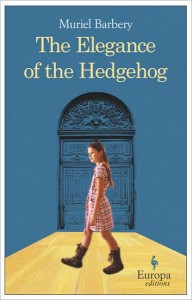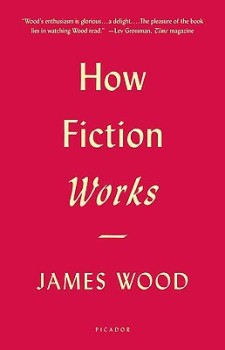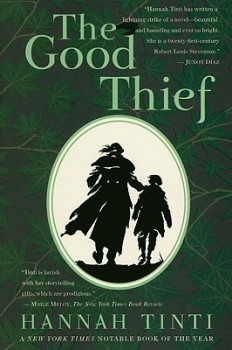 I’ve been trying to read Muriel Barbery’s critically acclaimed novel The Elegance of the Hedgehog, and while I’m relishing many of the author’s ideas, they feel to me like just that–the author’s ideas, not ones that belong to the book’s characters; a wealthy pre-teen and middle-aged concierge spend at least the first section of Hedgehog (I’m on p. 114) hiding their gifted selves from everyone they know while sharing them, mostly in monologue/journaling style, with us. Their use of language is almost identical, as is their attitude toward (and analysis of) the world around them. So much of the book feels like an experiment, an argument against our society’s encouragement of mediocrity (which, hey, I couldn’t agree with more). And Hedgehog‘s alternating first-person confidences feel anything but personal; the characters, their beliefs, and the small, lovely epiphanies they record are ever being explained to me. As a result, I feel distanced from them, aware of their fictionality. I don’t believe it’s Renee who has these thoughts or Paloma who is keeping this journal because on every page, I see Barbery holding the strings. Why is this so irksome, especially when she’s a lovely writer, both playful and smart?
I’ve been trying to read Muriel Barbery’s critically acclaimed novel The Elegance of the Hedgehog, and while I’m relishing many of the author’s ideas, they feel to me like just that–the author’s ideas, not ones that belong to the book’s characters; a wealthy pre-teen and middle-aged concierge spend at least the first section of Hedgehog (I’m on p. 114) hiding their gifted selves from everyone they know while sharing them, mostly in monologue/journaling style, with us. Their use of language is almost identical, as is their attitude toward (and analysis of) the world around them. So much of the book feels like an experiment, an argument against our society’s encouragement of mediocrity (which, hey, I couldn’t agree with more). And Hedgehog‘s alternating first-person confidences feel anything but personal; the characters, their beliefs, and the small, lovely epiphanies they record are ever being explained to me. As a result, I feel distanced from them, aware of their fictionality. I don’t believe it’s Renee who has these thoughts or Paloma who is keeping this journal because on every page, I see Barbery holding the strings. Why is this so irksome, especially when she’s a lovely writer, both playful and smart?
This question leads, of course, to more questions, winding ones that haunt much of How Fiction Works (and many writing classroom discussions): When considering point-of-view, where does the author’s voice end and a narrator’s and/or character’s begin–and where (if anywhere) might they overlap? How seamless does the relationship between writer and narrator have to be, and how much should authors be aware of it as we write? How does point of view influence other aspect of craft, from characterization and dialogue to the choice of a single word, to the rhythm of a sentence?
 One of my favorite terms used throughout How Fiction Works is “free indirect style.” Wood coins it to describe a third-person point of view that manages to subtly and, well, indirectly, attribute a thought or emotion to a character. Here’s a simple example p. 10: “Ted watched the orchestra through stupid tears.” We know to attribute the word stupid to Ted, and we get a wonderful, immediate sense of how he feels (ashamed). Another writer might say, “Ted watched the orchestra through tears, embarrassed but unable to stop crying,” but it is much less powerful; someone has stepped in to tell us overtly what Ted is feeling, and so we are aware there is another person in the room, helping us read the text. But when Ted watches the orchestra through stupid tears, we are delighted voyeurs, we are in the situation. Who does a word belong to, character or author? Wood notes that in this case, the word stupid belongs to both.
One of my favorite terms used throughout How Fiction Works is “free indirect style.” Wood coins it to describe a third-person point of view that manages to subtly and, well, indirectly, attribute a thought or emotion to a character. Here’s a simple example p. 10: “Ted watched the orchestra through stupid tears.” We know to attribute the word stupid to Ted, and we get a wonderful, immediate sense of how he feels (ashamed). Another writer might say, “Ted watched the orchestra through tears, embarrassed but unable to stop crying,” but it is much less powerful; someone has stepped in to tell us overtly what Ted is feeling, and so we are aware there is another person in the room, helping us read the text. But when Ted watches the orchestra through stupid tears, we are delighted voyeurs, we are in the situation. Who does a word belong to, character or author? Wood notes that in this case, the word stupid belongs to both.
This is the most exciting (yet mystifying) thing about free indirect style: at its finest, it allows an author to use writerly language alongside words that belong utterly to that character’s vocabulary and experience. Here’s another example from Wood (p. 14), from Henry James’s What Maisie Knew; the third-person narration stays close to a little girl’s (Maisie’s) point of view as she recalls going with her governess, Mrs. Wix, to visit the cemetery where the woman’s dead daughter is buried: “Mrs. Wix was as safe as Clara Matilda, who was in heaven and yet, embarrassingly, also in Kensal Green, where they had been together to see her little huddled grave.” Wood stresses that here the word embarrassingly is all Maisie’s, while the word huddled is James’s; they work together to convey the wealthy child’s discomfort (one she can’t fully understand) at the meagerness of the earthly resting place of a servant’s child–and the sadness (again, beyond her rational comprehension) of another young girl’s death. “Huddled” may not be the word Maisie would use, but it helps complete an emotion she can’t quite convey with mere embarrassment.
Ideally, the tension between these styles (the author’s and the character’s) is invisible to the reader but yields the result of a way in to a character, one less direct yet more revealing than hearing his or her first-person account, or an author-narrator’s neatly formulated analysis. Wood also explores what he calls “unidentified free indirect style,” which indirectly attributes thoughts or feelings to a larger group of people or even a society, a village chorus effect.
 A cohesive point of view is so crucial to a well-written piece of fiction — it’s both the entryway of and map to any work — but like “theme,” it’s very difficult to talk about. And so I welcome any attempt, like Wood’s, to tease out its layers–the languages of its author, its narrator, its character(s), and–as Wood points out–its larger world (regardless of how much said world resembles ours). What pleases me about the way How Fiction Works takes it on (focusing largely on free indirect style), is that Wood does not merely mention it in the first chapter and then abandon the topic; he brings it up again when discussing the evolution of the novel’s form, when discussing language, rhythm, characterization, character-appropriate metaphor, dialogue… In a chapter titled “A Brief History of Consciousness,” Wood notes (p. 147) that the advent (in novel form) of an “invisible audience” allows fiction “to become the great analyst of unconscious motive, since the character is released from having to voice his motives; the reader becomes the hermeneut, looking between the lines for the actual motive.”
A cohesive point of view is so crucial to a well-written piece of fiction — it’s both the entryway of and map to any work — but like “theme,” it’s very difficult to talk about. And so I welcome any attempt, like Wood’s, to tease out its layers–the languages of its author, its narrator, its character(s), and–as Wood points out–its larger world (regardless of how much said world resembles ours). What pleases me about the way How Fiction Works takes it on (focusing largely on free indirect style), is that Wood does not merely mention it in the first chapter and then abandon the topic; he brings it up again when discussing the evolution of the novel’s form, when discussing language, rhythm, characterization, character-appropriate metaphor, dialogue… In a chapter titled “A Brief History of Consciousness,” Wood notes (p. 147) that the advent (in novel form) of an “invisible audience” allows fiction “to become the great analyst of unconscious motive, since the character is released from having to voice his motives; the reader becomes the hermeneut, looking between the lines for the actual motive.”
Free indirect style empowers the reader, then. It both involves us in the story and trusts us to draw some of our own connections, as we do in life. Of course we feel more that such characters are more “real” when we are allowed to puzzle over them somewhat as we would our real-life friends, loved ones, and adversaries. And there’s the added bonus, in fiction, that we are privy to these people’s “stupid” thoughts.
Nearly invisible yet artful point of view (in first, second, third, omniscient, what-have-you) draws us in, makes fiction feel (not just seem) real.
When Hannah Tinti came to talk to my writing students, she said that she almost always writes in the third person, as she did in The Good Thief, and she discussed the specific challenges of choosing language and images in that novel, which stays close to a 12-year-old boy’s point of view (third-person limited). The language in The Good Thief is gorgeous, yet Tinti noted that she was  careful not to let the book’s images and descriptions stray too far from this young boy’s (Ren’s) own experience. When Ren encounters new places or people, we can see how deeply his perceptions have been influenced by growing up at Saint Anthony’s orphanage. Each new encounter calls to mind a certain prayer, the sound of birds throwing themselves against the windows of Saint Anthony’s kitchen, a wishing stone flung into a well, a certain farmer who used to kiss his horse on the nose. And because it is in the third person, the novel can occasionally use a well-placed word Ren might not know–citrus, opium, smattering–when other characters are around, without incident.
careful not to let the book’s images and descriptions stray too far from this young boy’s (Ren’s) own experience. When Ren encounters new places or people, we can see how deeply his perceptions have been influenced by growing up at Saint Anthony’s orphanage. Each new encounter calls to mind a certain prayer, the sound of birds throwing themselves against the windows of Saint Anthony’s kitchen, a wishing stone flung into a well, a certain farmer who used to kiss his horse on the nose. And because it is in the third person, the novel can occasionally use a well-placed word Ren might not know–citrus, opium, smattering–when other characters are around, without incident.
As writers, how much do you consider point-of-view as you work (particularly as you revise), and how much bearing, deliberate or instinctive, does it have on your use of language? Do you ever consider it as readers? When and how does overstated point-of-view or authorial language get in the way?





